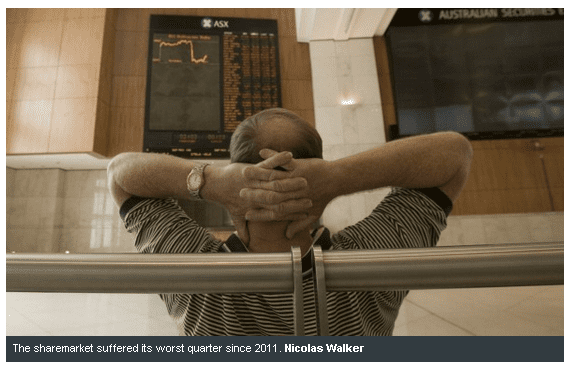
The Australian sharemarket has suffered its worst quarter in four years, and fund managers say the volatility that characterised it is likely to continue into the fourth quarter, led by the global themes of China and US interest rates.
The benchmark S&P/ASX 200 closed the third quarter 8 per cent lower, accelerating the previous quarter loss of 7.3 per cent. It marks the worst quarter since the European debt crisis in 2011, when the sharemarket fell 13 per cent.
Fears of a steep economic slowdown in China hit resources stocks particularly hard, as global commodity prices fell. Energy was the local market’s worst performing sector in the third quarter, plunging 26 per cent, followed by materials, down 12.8 per cent. Financials dropped another 9.1 per cent, extending a selloff that began in the second quarter.
Just two sectors posted gains over the three months: industrials rose a modest 2.4 per cent, buoyed by a sinking Australian dollar, while utilities gained 1.3 per cent, as investors sought the refuge of comparatively safe earners.
The dismal three months to September 30 is shared by global peers, with both the S&P 500 and Dow Jones Industrial Average down more than 8 per cent. London’s FTSE 100 is 9 per cent lower while the German DAX index has fallen 13 per cent.
“The main theme was that concerns over [growth in] China went global,” BetaShares chief economist David Bassanese said. “China has now started to impact on Wall Street, where previously it was only impacting on Australian and Asian markets.”
The second theme was the US Federal Reserve’s “bumbling” efforts to raise interest rates. Choosing not to raise rates as anticipated at its meeting in September added to the anxiety rather than allayed fears, Mr Bassanese said.
Peter Mavromatis, chief investment officer at Melbourne-based Beulah Capital expects market volatility to be a mainstay of the fourth quarter with investors weighing improved US economic data and with that the likelihood of the Fed raising interest rates by December against weaker data from China.
But given the multi-directional macro drivers, Dr Mavromatis said he was not taking a position in either the bear or bull camp.
“We believe rising corporate activity will put a floor under the market with profit-taking opportunities placing a lid on the upside,” he said.
Mr Bassanese said rather than looking oversold, the market was close to fair value.
The forward price-earnings ratio of the ASX 200 has fallen from its February peak of 16.2-times earnings, to around 14.5-times, but still above the longer term average of 13.5-times.
“It is certainly not cheap; it is premature to say the correction is over anytime soon,” he said.
Stephen Roberts, chief economist at Altair Asset Management said however the sharemarket was ripe for bargain hunting.
“Recent share market action is hinting at a very weak global growth outlook, possibly a recession,” he said.
“The outlook is not that bad in our view and there could be some immediate-term positive signs in both the US and China that leave share markets, especially the local share market, ripe for bargain hunting”.
Romano Sala Tenna, portfolio manager at Perth-based Katana Asset Management said the recent price action suggested moves lower than higher in the foreseeable future.
“We don’t have confidence in the indices, people are selling in the rallies and they’re not buying the dips. That is classic bear market behaviour.”
There was value to be found, he said, with the health sector holding up better than the rest, and technology stocks which were still enjoying “a fair bit of hype” particular in the app development and social technology industry.
